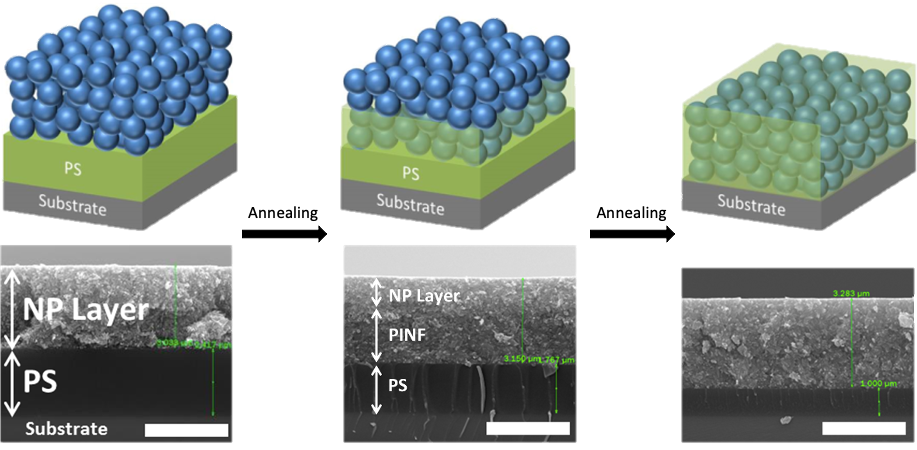
Polymer-infiltrated nanoparticle films
Polymer nanocomposite films (PNCFs) combine the unique properties of nano materials with the toughness, flexibility and high processability of polymers, resulting in materials with synergistic properties and functionalities. Despite their utility in a number of advanced applications, PNCFs with high concentrations of nanoparticles (NPs) are difficult to prepare because of their poor processability.
We have recently developed a new method to prepare PNCFs with extremely high loadings of NPs (volume fraction > 50%) by inducing the infiltration of a polymer into a film of densely packed NPs. This method involves capillary rise infiltration (CaRI) of polymer into a dense packing of NPs. In CaRI, a two-layer film, consisting of a porous layer of NPs and a layer of polymer, is first prepared and subsequently this bilayer structure is annealed above the glass transition temperature of the polymer. Thermal annealing induces polymer infiltration into the interstices of the NP layer.

(Top) schematic illustration of capillary rise infiltration of polymer melt into a NP packing, and (bottom) SEM images showing changes in polymer thickness upon infiltration and pores of NP packing filled with the polymer
Polymer infiltration into NP films can also be induced via solvents. Solvent driven infiltration (SIP) occurs when exposure to solvent vapor leads to capillary condensation, causing plasticization of the polymer and subsequent infiltration of the polymer into the NP layer. The objective of this work is to understand the dynamics of polymer infiltration into NP films and to understand the processing- structure relationship of PNCFs generated based on this process.
Schematic illustration of SIP into a NP film; a polymer-NP bilayer is annealed with solvent vapor, leading to capillary condensation of solvent in the NP packing, followed by swelling and infiltration of polymer
Patterning polymer-infiltrated nanoparticle packings using Leaching-enabled Capillary Infiltration(LeCaRI)


Polymer-infiltrated nanoparticle films are nanocomposites with unusual and synergistic physical properties due to the extremely high loadings (well above 50 vol%) of nanoparticles (NP). Patterning these highly filled PINFs could be extremely useful for applications that require lateral modulation of properties. In this method, we use leaching of mobile, uncrosslinked species from an elastomer network to enable rapid patterning of PINFs at room temperature without use of any solvents.
